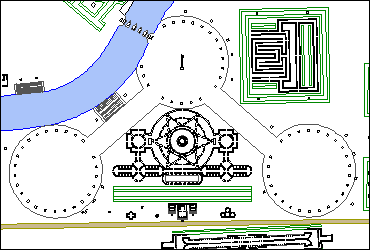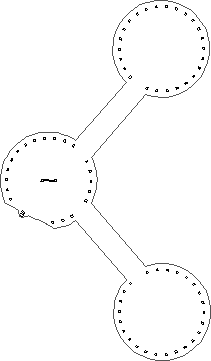Redrawing History - fertilized architecture
1997.08.16
...begin the analysis of the Campo Marzio as fertilized architecture with the Porticus Neronianae. The plan itself is like the proverbial missing link because it has both the traditional and the new geometric state all in one design. There is also the solid/void issue which leads directly to the intercourse building in terms of inside/outside, figure ground, penis/vagina, male/female.
...there are references to fecundity in Tafuri, Wilton-Ely, and Fasolo.
Did Piranesi's own imagination itself reach a new "fertilized" state--a state where creative manifestation began to occur exponentially rather that merely linearly?
genetic 1 a : relating to or determined by the origin, development, prior history, or causal antecedents of some phenomenon : CAUSAL, HISTORICAL, EVOLUTIONARY b : based on or determined by evolution from a common source -- used esp. of relations among languages or among words and grammatical forms of languages c : concerned with or seeking to explain, interpret, or understand (as a literary or psychological phenomenon) in terms of its origin and development or of its causal antecedents 2 : of or relating to genetics : characterized or produced by processes of genetics
genetic 1 a : a branch of biology that deals with the heredity and variation or organisms and with the mechanisms by which these are effected 3 : GENESIS
continual mistakes and reversals
1998.02.15
After seeing how the figure captions are inverted with regard to the Ichnographia and the Nolli Plan in the Peter Eisenman section of Autonomy and Ideology, it reminded me of the other mistaken inversions that I have found in other texts on the Ichnographia. For example, the east/west and other mistakes (Equirria and Antoninus Pius) of Fasolo, the mis-characterization in the Ichnographia-Jerusalem essay, the mention of inversion in the Allen essay, and my own mistake about the direction of the Triumphal Way. I find these mistakes to be uncanny, as if the Ichnographia had the power to confuse anyone who studied it (and here I can quote Kreiger).
"Rome's Campus Martius suggests an impossible tension among competing parts, perhaps even anarchy. The engraving itself seems to pulsate and change patterns as one studies it."
The strange thing is that Piranesi seems to make the same kind of (archeological) mistakes.
Tafuri, Manfredo
1998.11.16
After an extended independent analysis of the Ichnographia Campus Martius, it becomes evident that Tafuri misreads Piranesi's large plan in most cases. Tafuri's text indicates no research of the plan beyond simply looking at it and subsequently offering a description of what Tafuri thinks he sees. (In fact, a careful reading of both Tafuri's texts and the text of Fasolo from 1956, clearly shows that Fasolo's text greatly influenced Tafuri's observations.) For example, in calling out the various axes of the Campo Marzio, Tafuri notes the axis running through Hadrian's Tomb, but he fails to recognize it's symbolic function as the Axis of Death; nor does he identify the Axis of Life that runs perpendicular to the Axis of Death. Moreover, Tafuri marginally notes the semblance of an axis within the northeast sector of the plan, yet he never mentions that Piranesi labeled this axis the Equiria, place of the annual horse races instituted by Romulus in honor of Mars.
These are just two examples which plainly demonstrate that Piranesi's plan holds significant and coherent symbolic content, however, recognition of Piranesi's "carved in stone" symbolism necessarily negates Tafuri's primary thesis that the Ichnographiam Campi Martii is utterly fragmented and devoid of "language." Ironically, had Tafuri not discounted the presence of language and instead actually translated the hundreds of Latin labels Piranesi applies throughout the plan, he would have concluded with a more accurate, if not also a more honest reading.
It is truly unfortunate that the subsequent 20th century Campo Marzio analyses of Allen, Bloomer, and Eisenman, build upon Tafuri's mistakes rather than correct them.
| |
Circulus
Ludus
1998.12.01
circulus : a circular figure; a circle
Ludi : public games, plays, spectacles, shows, exhibitions, which were given in honor of the gods, etc.
ludus : a place of exercise or practice
|
The three large Circulus of the Ichnographia occur between the left bank of the Tiber and the west side of the Equiria, within the northern-most region of the large plan. These circular planes are connected by two Ludus, which are military parade grounds. Essentially, the three Circulus, the two Ludus, and the many Statuae Virorum illustrium (statues of illustrious men) constitute Piranesi's rendition of ancient Rome's formal setting for its military parades and exercises. These broad open areas, along with the activities they facilitate, comply fully with the Equiria's overall character as ancient Rome's military headquarters and as a tribute to Mars. Moreover, placement of the Officinae Armorum and the Officinae machinarum militarium right in the center of the parade fields further reinforces the military specificity of Piranesi's design intention.

Fasolo, a mid-twentieth century art historian, criticized the Circulus and Officinae Armorum complex as "a triangular and star-shaped system to which it is certainly not possible to find a comparison in classical typology." Although Fasolo's observation is correct, it is nonetheless unfortunate that he did not recognize the overriding "Martian honor" theme of Piranesi's Equiria design. Furthermore, Fasolo failed to detect the pattern of inversion Piranesi employs throughout the Ichnographia, particularly with regard to the large plan's archeological and historical inconsistencies, and, in this case, the circular and triangular formation of Piranesi's parade grounds may well represent an inverted delineation of ancient Rome's real military grounds, the huge square shaped Praetorian Camp, which was in an altogether different section of the city.
| |

Circulus with Ludus and Statuae Virorum illustrium
The three Circulus of the Ichnographia are large circular planes, each almost 1000 feet in diameter and decorated with Statuae Virorum illustrium (statues of illustrious men) along their perimeters. The two outer circles are connected to the inner circle by two Ludus (places for public games, etc.).
|
Equiria
1998.12.01
Portrayed as both the home of Rome's military operations and the site of Rome's oldest annual festivity, Piranesi's Equiria takes on a symbolic significance beyond just the honoring Mars. Within its overall Campo Marzio context, the Equiria, as both age-old secular/equestrian axis and axis of war, represents the backbone of ancient Rome's civic and martial pride.
Fasolo (1956) mistakenly identifies the Equiria as a "minor river," and Tafuri sees the Equiria as a "second alignment, regulated by a rectilinear axis." Both Italian historians failed to recognized the Equiria's true symbolic and urban design significance.
cloning architecture - a global search
2004.06.16 05:53
On the Campo Marzio issue, I've (already) compiled a bibliography of architectural literature on Piranesi's large plan. Briefly, before Tafuri there is Fasolo in 1956 (who Tafuri in places reiterates, but he did not note any of the 1956 mistakes), and Scully on Kahn in 1962. Tafuri's Architecture and Utopia was first published in Italian in 1973, and his The Sphere and the Labyrinth was first published in Italian in 1980. Since 1980, most architectural writers have sprouted off the Tafuri branch, and there is only one architectural writer who, in 1981, began to sprout off Kahn's branch of investigation entwined with reenactment.
2014.01.25 15:15
25 January
Finished reading Manfredo Tafuri: Choosing History this morning, and Leach is quite a good analyst and writer. I'd like to relate two passages, one from the begining and one from the end. On page seven: "Beginning his studies in October 1953, Tafuri faced the disconcerting reality that the University [of Rome] remained stocked with professors appointed under the Fascist regime. Over the duration of his diploma studies, he came to openly oppose several of these. His "hit-list" included Enrico Del Debbio, Ballio Morpurgo, Vincenzo Fasolo and, most explicitly, Saverio Muratori. He complained of their lack of interest in teaching, their distance from the classroom and their reliance on assistants to deliver the cirriculum. He begrudged their prejudice against modern architecture: "The operative principal was that contemporary architecture must not enter the cirriculum. It was considered a heresy." It is thus now easy to speculate that Tafuri specifically set out to "modernize" Fasolo's analysis of Piranesi's Campo Marzio. If such is the case, then Tafuri also just continued Fasolo's mistakes. On page 269-270: "In "The loneliness of the Project", Groys argues that the work practices of artists, philosophers, writers, scientists, and so on assume a fundamentally existentialist stance in the relation to their project to the external conditions of day to day life. He conceives of the project as intellectual work that is isolated and independent; its manifestations represent the project, but remain distinct from it. The very notion of the project, as Groys portrays it, invokes a fine balance between a common scale of time shared by all and a temporal field inhabited by an artist. In each instance that an artist proposes a project--to an ethical panel, funding committee, gallery, etc.--he or she advances a scheme for the future. To begin the project is to commence the realization of that programme. Anchored not to the vicissitudes of the present world, their vision is imbued with critique, hope of the anticipation of consequence. It is thus fundamentally utopian, an expression of the need to surpass the present: 'each project in fact represents a draft for a particular view of the future, and each case can be fascinating and instructive.' Despite the completeness with which the artist might conceive of this future, from the outside one may simple engage with its "evidence"." Choosing to "build" a virtual museum of architecture is definitely a project.
|

